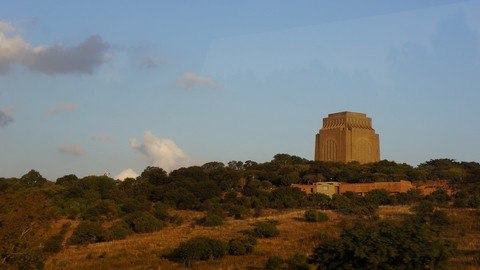The Voortrekkers were instrumental in making South Africa what it is today. The Voortrekker Monument has become one of South Africa’s most controversial monuments. Built between 1937 and 1949, the structure is 40m high, long and wide, and was designed by Gerard Moerdijk, an architect fascinated by the mysteries of the Egyptian pyramids.
 |
| The Voortrekker Monument is built entirely of sandstone. |
The monument is surrounded by a carved stone wall with 64 wagons in a traditional circular defensive line. The structure is a giant monolith, each corner bearing the face of a great African hero. Inside is a large space with a high vaulted ceiling and marble reliefs depicting the journey of the Dutch settlers.
This structure has a hole in the roof, calculated so that at exactly 12 noon on December 16th every year, the sunlight will shine straight from the top to the bottom of the tower. And where the sunlight shines, is a large granite slab with the inscription "Ons vir Jou, Suid-Afrika" (We dedicate ourselves to the People - South Africa). "Voortrekker" means "discoverers" in Afrikaans (South African language, built on the foundation of Dutch). And December 16th is the day that the Dutch swore an oath to die with the Zulus (South African natives) to enter a bloody war for survival with more than 500 "voortrekkers" packed into 64 metal horse-drawn carts, attacking head-on with guns...
 |
| The inscription "Ons vir Jou, Suid-Afrika" - We dedicate ourselves to you - South Africa. |
Inside the memorial, the four walls of the ground floor of the tower are carved in stone, depicting the story of the pioneers, the war with the British, the agreements and betrayals of the Zulus chiefs towards Retief, one of the white chiefs, the War of the 64 Carts, and how the Zulus later submitted. When the African National Congress (ANC) came to power, it was very much wanted to destroy this monument because for whites, the memorial was a testament to historical victory, but for blacks, it was evidence of defeat.
 |
| The bas-relief inside the memorial depicts the Zulus chief signing a treaty with Retief, a leader of the white settlers. |
The memorial has been preserved to this day thanks to the intervention of President Nelson Mandela. Because it is only a 15-minute drive from the center of Pretoria, it has now become a popular tourist attraction on the journey to discover the history, country and people of South Africa. To date, the memorial is considered a powerful symbol of the “white tribe of Afica” as well as the expansion of South Africa by the Dutch “voortrekkers”. Along with that, by an elevator and stairs leading to the roof of the memorial, visitors will have a wonderful panoramic view of Pretoria.


































